|
Design Tooling - Bidirectional Design
|
 |
|
|
|
Return to front page
|
| |
|
| |
|
|
Information
|
Introduction
Beyond parametric modeling it is possible to introduce constraints
to model geometry as for instance fix an angle to a certain value
or the length of a line. In order to explore the sum of the constraints
in a interactive fashion a solver is necessary for solving for the
new state of the model. CATIA for instance has such a solver setup
in its sketch environment. It operates on geometric entities and
their respective constarints.
Designing backwards and forwards is a common activity. Bidirectional
refers to the notion of designing an artifact to achieve a certain
phenomena and then to be able to adjust the phenomena which in turn
again updates the artifact.
The ability to interact and edit at any step in the dependency chain
of a design model. One approach is to model the phenomena in the
same representation as the artifact as for instance in the case
of a mirror and the related light paths.
There is a number of metaphorical models for computation
(Travers 1996)
Imperative model, functional model, procedural
model, object model and the constraint model
|
| |
|
|
Background
|
Metaphors in computation
There is a number of metaphorical models for computation
(Travers 1996)
Imperative model - computer as sequential
instruction follower
functional model - computation of values
procedural model - integration of imperative
and functional model - decomposition of programs into parts
object oriented model - organization of
the program around the data it manipulates - metaphor of objects
constraint model - combination of procedure
with declarative information about what they do.
The constraint model is the one that most closely
fits the bidirectional design model. It allows the specifications
between objects while leaving the procdural details of how to enforce
these relations up to the constraint solving system (Travers 1996)
|
| |
|
|
Exercises
|
Framework
A possible design exercise could be to have the student identify
a relationship between an object and a phenomena and identify the
dependencies and criteria that link the two.
A second step could be to model them in a bidirectional
relationship either in digital geometric form or as a physical constraint
apparatus.
The computer is mostly perceived as a machine that
gives results to clearly defined problems - the solver based constraint
systems allow explorative design behavior while providing excact
results none the less. The core challenge is to understand the relationship
between the different design goals.
|
| |
|
| |
|
| |
|
|
Implementations
|
Concert Hall Light Study sketch in CATIA
Implemented with the parametric modeler as CATIA
for instance. A bidirectional solver allows for the interaction
with any elements in a constraint geometry effectively allowing
editing of the result or of the artifact. This is powerful when
for instance non tangible phenomena like light sound or relationships
between objects are modeled in geometric fashion and manipulated
just as objects are.
|
|
Axel Killian 2002 in CATIA
|
|
 |
 |
 |
 |
|
| |
- relation between mirror and object
|
- parabolic mirror and light rays
|
- Louvers and light paths
|
|
| |
|
| |
|
|
|
Sketchpad - Commercial software
Sketchpad is a dynamic construction and exploration
tool that enables students to explore and understand mathematics
|
|
SketchPad Geometer(tm)
|
|
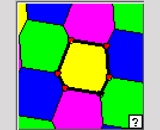 |
 |
|
|
|
| - mechanism |
- mechanism
|
|
|
|
| |
|
| |
|
| |
Graphic statics - Active statics - Edward Allen,
Simon Greenwold
An example of designing in two domains in parallel.
The user defines the topology of the mesh and gives geometric constraints
and weights and a state of equilibrium is found through solving
the equations of the statically determined model. This method only
works for statically determined structures.
|
| |
|
| |
|
|
Edward Allen
|
|
Simon Greenwold Edward Allen
|
Axel Kilian
|

|
 |

|
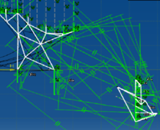
|
| |
Graphic statics examples by Edward ALlen, technique
originally developed around the turn of the century
|
Active statics by Edward ALlen and Simon Greenwold
|
Catia based example by Axel Kilian using bidrectional
solver in the sketcher
|
| |
|
| |
|
| |
Graphic statics in generative components/microstations
- with 3d volumetric model attached
The graphic statics geometric pair of form polygon
and force polygon allow the bidirectional exploration of the bridge
structure and a 3D volumetric model provides an additional view
of the build structure
|
|
Axel Kilian 2003
|
|
|
|
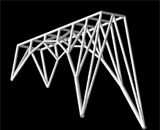
|

|
|
| |
Graphic statics examples done interactively in Generative
Components inside Microstation
|
A form diagram is linked to a force polygon. The
combination of both drive a 3D volumetric model
|
The thicknesses of the members are proportional
to the forces going through them
|
|
| |
|
| |
|
| |
Digital form finding tool developed for/in
Gaudi workshop spring 2004 with John Ochsendorf, Barbara Cutler,
Marty and Eric Demaine and Simon Greenwold
An example of designing in parallel. The user
defines the topology of the mesh and gives geometric constraints
and weights and the solver searches for a state of equilibrium.
The model currently does not allow bidirectional
moves since the solver is applied to finding the state of equilibrium
among the forces present. The solver would have to be extended to
allow for additional constraints to be modeled and manipulated byt
the designer.
|
|
Axel Killian 2004
|
|
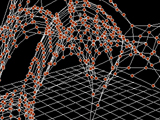 |
 |
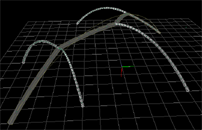
|
|
| |
Connecting mass and strings generates form based
on simulated gravity
|
Thickness attribute based on force present in the
member
|
|
| |
|
| |
|